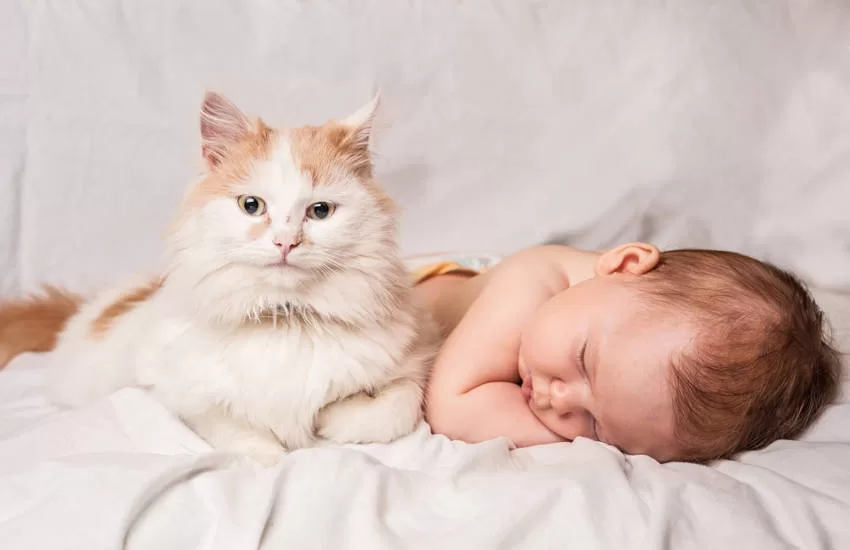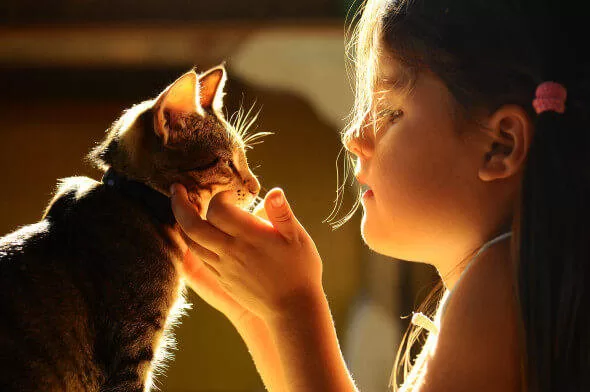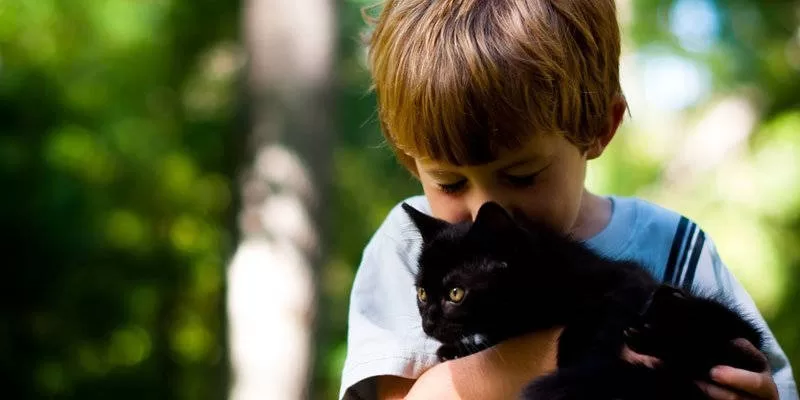Introduction to compatibility between cats and children
The coexistence between cats and children can be extremely rewarding and beneficial for both parties. However, it is important to ensure that this interaction is safe and positive for the well-being of everyone involved. In this article, we will discuss how to promote a harmonious coexistence between cats and children, from preparing the house for the cat’s arrival to the correct way of interaction between them.
Benefits of living together between cats and children
The coexistence between cats and children can bring a number of benefits to both small and felines. This safe and positive interaction can help children’s emotional, social and cognitive development, as well as promote a more harmonious home environment.
One of the main benefits of coexistence between cats and children is the stimulation of a sense of responsibility. Taking care of a pet, such as feeding it, cleaning its litter box and playing with it, can teach children values such as commitment, care and empathy. These responsibilities also help build children’s self-esteem and confidence as they realize they are capable of caring for another living being.
Also, interacting with cats can help children develop social skills. Felines are animals that require patience, respect and calm, and children learn to communicate with them properly. This includes understanding the signs that the cat is stressed or doesn’t want to be disturbed, respecting her personal space and ways to play with her without hurting her.

Cats can also be a source of emotional comfort for children. They are known for their ability to calm and relax people, and this can be especially helpful for children who are experiencing stress, anxiety or sadness. The presence of a cat can provide a sense of security and emotional support, helping children to cope better with their emotions.
Finally, living with cats can stimulate children’s creativity and imagination. Cats are mysterious and independent animals, which can arouse children’s curiosity and imagination. They can invent stories and games involving cats, which contributes to the development of creativity, critical thinking and problem solving skills.
In summary, the coexistence between cats and children offers a series of benefits, such as the development of responsibility, social skills, emotional comfort and stimulation of creativity. However, it is important to ensure safe and supervised interaction between children and cats, respecting the limits and well-being of both.

Preparing the house for the cat’s arrival
Before bringing a cat home, it is important to prepare the environment so that it feels safe and comfortable. There are some measures that can be taken to ensure that the house is a suitable space for the coexistence of the cat and the children.
First, make sure you have a designated space for the cat, such as a designated area with a bed, food and water bowls, and a litter box. This area should be out of reach of children, ensuring a quiet place for the cat to rest and feel safe.
In addition, it is important to analyze the security of the house. Make sure there are no dangerous or toxic objects within reach of the cat and the child. Cleaning products, toxic plants and electrical wires must be stored in safe places, avoiding accidents.
Another important aspect is to provide environmental enrichment for the cat. This can be done through interactive toys, scratching posts, shelves and even a cat tree. These options help keep the cat entertained and stimulated, preventing unwanted behavior.
In addition, it is essential to prepare children for the arrival of the cat. Explain to them how they should interact with the animal and teach the importance of respecting the cat’s space and limits. Instruct children not to disturb the cat while it is sleeping or eating, and not to pull its tail or ears.
Finally, it is important to ensure that the cat has adequate nutrition and regular veterinary care. Take him to the vet to check his health and make sure he’s up to date on his shots and deworming.
By adopting these measures, the house will be prepared to receive the cat and provide a safe and harmonious coexistence between the animal and the children. Remember to always monitor interactions between them and provide adequate supervision to ensure the safety of both.

Introducing the cat to the child safely
Once the home is properly prepared for the cat’s arrival, it is important to introduce the new family member to the child safely. This will ensure that the interaction between them is positive and stress-free.
1. Patience and graduality: It is essential to allow the cat to get used to the environment before introducing it to the child. Give the cat space and time to explore the house, become familiar with the smells and feel safe.
2. Familiar smells: Before introducing the cat to the child, it is recommended that the child hold items with the cat’s scent, such as toys or blankets. This will help the cat associate the child’s presence with something positive.
3. Proper supervision: When it’s time to introduce the child to the cat, make sure an adult is present to supervise the interaction. This will prevent any sudden or aggressive behavior on the part of the child, ensuring the safety of both.
4. Gradual introduction: Start with brief encounters between the child and the cat, in a calm and peaceful environment. Allow the cat to approach the child of its own free will, without forcing the interaction. Respect the rhythm of the cat and do not force the presence of the child.
5. Positive reinforcement: Encourage the child to reward the cat with treats or praise whenever it shows appropriate behavior. This will help the cat associate the child’s presence with something positive and reinforce safe interaction.
6. Teach the child to respect the cat’s boundaries: Explain to the child that the cat may not like to be pulled, squeezed or chased. Teach her to pet the cat gently and respect her personal space. This will ensure that the interaction between them is respectful and positive.
Always remembering that the interaction between cats and children must be supervised and monitored continuously. Never leave a child alone with a cat, especially if he is very small.
By following these guidelines, you will be providing a safe and gradual introduction between your cat and your child, allowing them to develop a positive and harmonious relationship over time.

Teach children to interact with cats properly
It is essential to teach children how to properly interact with cats to ensure their safety and well-being. Here are some tips to help them learn to live with the cat in a respectful way:
1. Show respect for the cat’s boundaries: Explain to the children that cats have their own personal space and that it is important to respect that. Teach them not to disturb the cat while it is eating, sleeping or using the litter box. This helps create a trusting relationship between the cat and the child.
2. Teach soft touch: Cats are sensitive animals to physical stimuli. Show the children how to pet the cat gently, avoiding pulling the fur or making sudden movements. Reinforce the importance of treating the cat with kindness and delicacy.
3. Encourage appropriate play: Explain to children what types of cat play are safe and appropriate. Teach them to use interactive toys, such as wands with feathers or balls, to avoid games that could hurt the cat, such as pulling its tail or pulling its ears.
4. Teach how to identify the cat’s signs of stress: Explain to children that cats have body signs that indicate when they are stressed or uncomfortable. Show them how to recognize these signs, such as ears back, tail bristling or snarling. Encourage them to stop interacting immediately if they notice these signs.
5. Constant supervision: It is essential that interactions between children and cats are always supervised by a responsible adult. This allows the person to intervene if any negative situation occurs, ensuring the safety of both.
6. Positive reinforcement: Encourage children to reward the cat for good behavior, either with a treat or a pet. This creates a positive association in the cat’s mind towards interacting with the child.
7. Respect for the cat’s space: Teach children that when the cat hides in a safe place, they should leave it alone. This is especially important when the cat is adapting to a new environment or is feeling stressed.
8. Ongoing education: Always reinforce good cat interaction practices. Explain to the children that every cat is unique and may have different preferences. Encourage them to observe and learn about the cat’s communication signals so they can adapt and adjust their interaction as needed.
By following these tips, you will be helping children to develop a healthy and respectful relationship with the cat, promoting a happy and safe coexistence for everyone.

Teach children to interact with cats properly
Teaching children to interact with cats properly is essential to ensure a safe and harmonious coexistence between them. Here are some important tips:
- Respect the cat’s space: Explain to the child that cats are independent animals and like to have their own space. Teach respect when the cat does not want to interact or is resting in its corner.
- Avoid sudden movements: Young children may have difficulty controlling their movements and may frighten or injure the cat. Instruct the child to move gently around the cat and avoid sudden gestures that might startle the cat.
- Do not squeeze or pull the cat: Explain to the child that cats do not like to be squeezed or pulled hard. Show her how to pet the cat gently and respectfully, always avoiding touching sensitive areas like the belly and paws.
- Teach the importance of hygiene: Guide the child to wash their hands before and after interacting with the cat. Explain that cats are clean animals and it is important to maintain good hygiene to prevent the transmission of disease.
- Set boundaries: Teach the child to recognize the cat’s signs of discomfort, such as ears back, tail bristling or growling. Explain that when the cat shows these signs, it’s important to respect its space and stop interacting with it.
- Promote appropriate play: Guide the child to play with the cat using appropriate toys, such as wands with feathers or balls. Encourage the child to avoid play that involves the hands, as this can lead to the cat accidentally scratching or biting.
- Reinforce the importance of care and feeding: Encourage the child to participate in the care of the cat, such as feeding it and brushing its fur. Explain that caring for the cat is a shared responsibility and that the cat depends on us for its well-being.
Always remembering that adult supervision is essential during interactions between children and cats, especially when children are still very young. Teach the child to love and respect cats, and their coexistence will be full of happy and safe moments.
Dealing with common challenges and problems
Although the coexistence between cats and children can bring many benefits, it is also important to be prepared to deal with common challenges and problems that can arise. Here are some situations you might encounter and how to resolve them:
1. Cat aggression
In some cases, a cat can become aggressive towards children. This can be caused by a variety of reasons such as discomfort, fear or stress. If you notice signs of aggression such as growling, scratching or biting, it is important to intervene immediately to protect both the child and the cat.
An initial approach might be to separate the cat and child into separate rooms and allow both their space and time to settle down. Then look to identify the root cause of the aggression and work to resolve it. This may involve seeking professional help from a veterinarian or feline behaviorist.
2. Allergies
Some children may develop allergies to cats, which can be a challenge to get along with. If this happens, it’s important to see a doctor to get a proper diagnosis and receive guidance on how to manage allergies.
There are steps you can take to minimize exposure to feline allergens, such as keeping the environment clean, vacuuming regularly, washing bedding frequently, and limiting the cat’s access to the child’s rooms.
3. Child’s lack of interest or fear
Some children may not be interested in or even afraid of cats. It is important to respect the child’s limits and not force interaction with the cat. Instead, try to gradually encourage familiarity by allowing the child to observe the cat from afar and offering information about feline behaviors.
You can also try to involve the child in cat care activities such as feeding, brushing or supervised play. This can help create a positive association between the child and the cat over time.
4. Rough or aggressive play
Children often have an infectious energy and can be a little clumsy when interacting with cats. It is important to teach children how to play appropriately and gently with cats, without pulling the tail, squeezing or scaring the animal.
Supervise play between the child and the cat, offering guidance and teaching the importance of respecting the cat’s boundaries. If necessary, establish clear rules about how to interact with pets and monitor compliance with these rules.
The coexistence between cats and children can be a wonderful experience, but it requires attention and care to ensure everyone’s safety and well-being. Be prepared to deal with challenges and never hesitate to seek professional help when needed. With patience and proper guidance, interaction between cats and children can be a source of joy and learning for both.

Final thoughts and additional tips
Living with cats can bring many joys and benefits to children, but it is important to remember that this interaction requires constant care and supervision. Here are some final thoughts and additional tips to ensure a safe and happy coexistence:
1. Encourage accountability
Teach children the importance of caring for and respecting cats. Encourage them to participate in daily tasks such as feeding, cleaning the litter box and brushing the cat’s fur. This not only helps to strengthen the bond between the child and the cat, but also teaches important values.
2. Monitor interactions
Always be aware of interactions between the cat and the child. Watch to see if the cat is showing signs of discomfort or stress, such as arching its back, hissing, or trying to hide. If you notice anything out of the ordinary, intervene immediately to avoid any problems.
3. Respect the cat’s boundaries
Each cat has its own personality and boundaries. Some may like more intense hugs and cuddles, while others prefer gentler interactions. Teach children to respect the cat’s boundaries and recognize when the cat is no longer comfortable with interaction.
4. Provide a safe environment
Make sure the home is a safe environment for both the cat and the child. Keep chemicals, electrical cords and dangerous objects out of reach of the cat and child. Also, make sure the cat has access to areas where it can hide and rest when needed.
5. Consult a veterinarian
If any concerns arise regarding the coexistence between the cat and the child, do not hesitate to consult a veterinarian. They will be able to offer specific guidance and help resolve any behavioral issues that may arise.
The coexistence between cats and children can be very rewarding, providing a lasting friendship and mutual learning. With patience, supervision and mutual respect, it is possible to create a safe and harmonious environment for all. Always remember that the safety and well-being of everyone involved must be a priority, ensuring a safe and positive interaction between cats and children.
External Links:

